How to create a multi-vendor marketplace website
Multi-vendor marketplaces have exploded in popularity in recent years, and this growth shows no signs of slowing. Here’s why a multi vendor marketplace can be a great business – and how you can build your own. dasfgds
Table of Contents
Multi-vendor marketplaces have been around for centuries, starting with bustling city markets hundreds of years ago. These days, marketplaces look a little different: transactions are completed online, between people worldwide, for almost every type of product or service you can think of.
Multi-vendor websites are very different from regular eCommerce websites.
Regular eCommerce founders are their own standalone vendor – marketplaces can have thousands of vendors who all contribute to the supply. Entrepreneurs in the eCommerce space are responsible for sourcing products, setting pricing, fulfilling orders, and much more. On multi-vendor sites, these tasks are performed by individual sellers. An eCommerce operator focuses on building a large customer base, while the marketplace entrepreneur looks at building and balancing supply and demand. And so on. (Here's a thorough article on the benefits and challenges of the two-sided marketplace model.)
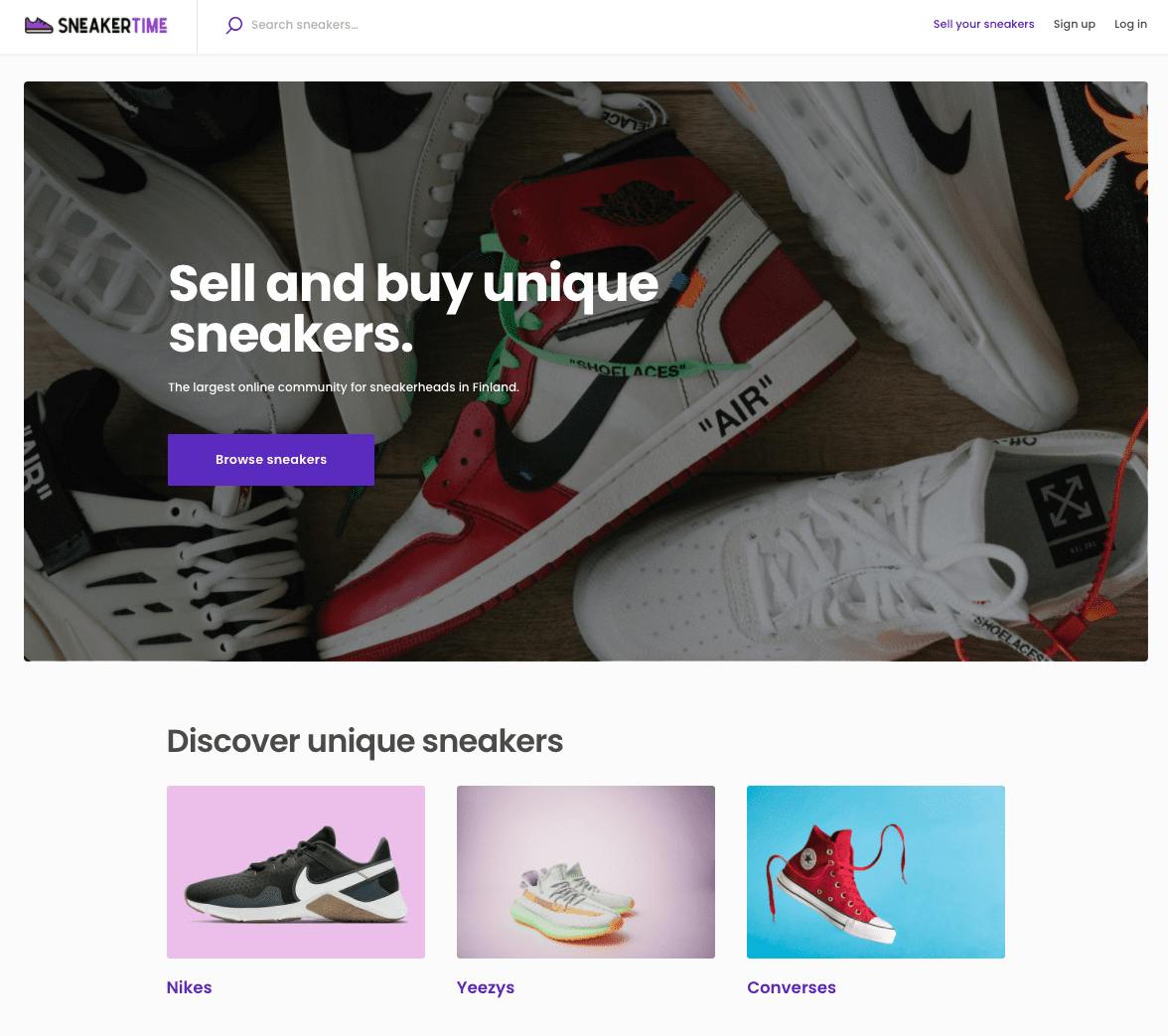
The fundamental difference between online stores and online marketplaces means that multi-vendor websites require entirely different features from traditional eCommerce sites. This impacts user profiles, reviews, online payments systems, admin panels, and much, much more.
Marketplaces run on a completely different business model too. Most of the revenue goes directly to sellers, with the marketplace owner usually taking a commission on sales. (We'll explore essential features and possible business models later in the article).
The marketplace business model is becoming increasingly popular among start-up founders and traditional eCommerce sites looking to stay relevant in the post-pandemic world. And with good reason.
Multi-vendor marketplaces are scalable and straightforward to create with marketplace software like Sharetribe's. They require no initial inventory to get started. They have the potential to unlock unrealized value in markets and to benefit from strong network effects. Let's look at the benefits of the model in more detail.
Marketplaces connect suppliers (sellers) with demand (buyers). The website acts as a trusted platform for the transaction to take place and usually charges some form of commission on every successful transaction.
This model offers considerable benefits for all parties involved: buyers, sellers, and entrepreneurs.
Benefits for buyers
Marketplaces remove a lot of the friction from the buying process, making it easier, faster, and cheaper for buyers to get what they want. With well-established multi-vendor websites, buyers also benefit from increased choice and can be confident in their purchases due to features like ratings, reviews, and profiles.
Let’s look at a real-life example, our customer The Octopus Club.
The Octopus Club is a marketplace for buying and selling pre-loved children's clothes and other items. Before Ana Rachel Estrougo founded the platform, she found it very difficult to find high-quality, pre-owned clothes for her rapidly-growing child.

For buyers, buying things new is not always the desired option. It's expensive and not sustainable in the long run. But when Ana tried to buy secondhand, she couldn't find a place that felt trustworthy. She wanted a place where she could be sure things would arrive clean or that they had been well kept.
The Octopus Club succeeded in solving these problems for the buyers. The Octopus Club became an online marketplace for parents to buy high-quality children’s clothing, toys, and accessories. A community of like-minded parents passing beloved items around formed.
Related: Learn more about The Octopus Club's journey
It’s not just buyers who benefit from the multi-vendor model, sellers do too. In fact, providing benefits to sellers should be a top priority for marketplaces: without them, there is no platform.
The primary benefit for sellers is access to a large group of customers. Any arts or crafts business could set up its own website and sell to customers. But why do that when they could list their products on Etsy, and sell directly to Etsy’s 82 million active buyers?
On the other hand, smaller niche websites with very targeted audiences can also offer significant business benefits for sellers. The Octopus Club is again a great example. Kids grow up fast. Clothes, accessories, and toys tend to pile up. Selling them on The Octopus Club lets parents pass on high-quality items that will make the next owner happy for extra cash and knowing you're contributing to a more sustainable future.
The sellers of a multi-vendor marketplace benefit from a bigger and more targeted audience.
In addition to exposure to bigger or more targeted audiences, many marketplaces also offer sellers better tools to manage their business. Sellers can more effectively manage inventory, learn how to optimize their pricing, and can communicate easily with buyers.
All in all, multi-vendor marketplaces represent a huge growth opportunity for sellers. A well-run marketplace gives birth to hundreds, if not thousands of businesses, creating economic security for sellers, their families, and their employees.
Benefits for marketplace entrepreneurs
Multi-vendor marketplaces are attractive businesses for entrepreneurs. The costs of starting up have become relatively low after the emergence of multi-vendor marketplace software. No-code builders make it easy to launch the site even without coding skills.
But by far the biggest benefit for entrepreneurs is the possibility of network effects.
Network effects boost the growth of a multi-vendor marketplace. When a platform has network effects, its value grows in line with the number of people that use it. An increase in sellers increases selection and price competition, which helps bring in more buyers to the platform. More buyers mean more business to the sellers, and so more sellers join the platform.
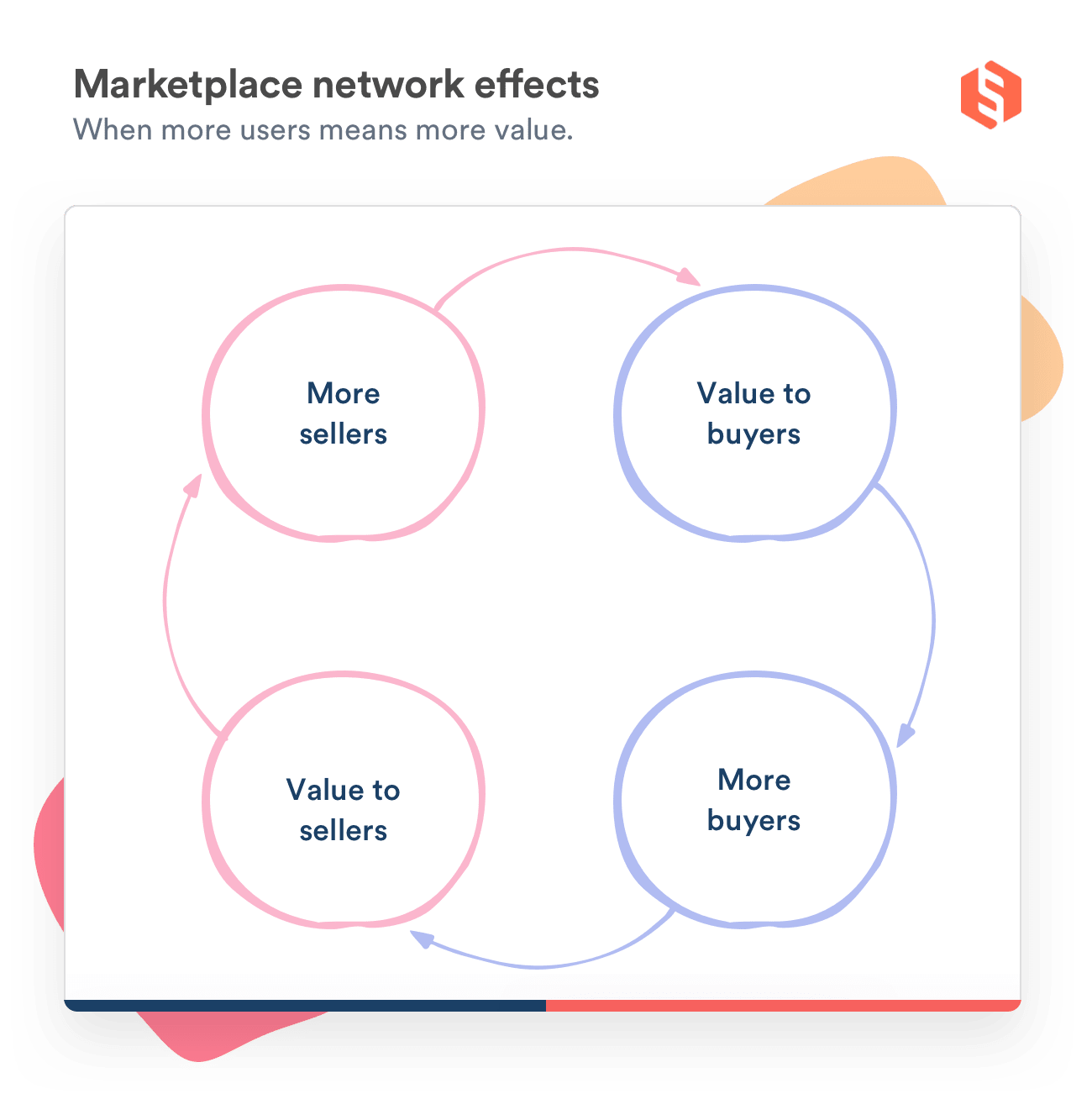
Entrepreneurs can also leverage buyer-seller overlap and cross-side virality to boost the network effects on their platforms. Cross-side virality occurs when getting a new seller to join the platform also brings you new customers. If a part of those customers turns into providers as well, you have a great growth opportunity on your hands.
Our customer, Vulpilist, is a great example. It's a marketplace for selling classical menswear. A high-quality seller, such as a menswear blogger or style influencer with a big selection of exclusive items, joins the platform. They also bring an existing audience – social media followers or customers from a previous platform. A few of them are hobbyists, too, with their own clothing and accessories to sell. They put their items to sell and bring in their existing audience – and on and on it goes.

Network effects are attractive to marketplace entrepreneurs because they can significantly speed up scaling the business – while reducing customer acquisition costs. As new users join, the platform's value increases for all users, which means that the entrepreneur can charge a higher commission from sellers. This loop continues infinitely. Multi vendor marketplaces that master it can achieve phenomenal scale.
Of course, building a multi-vendor website is not without challenges. Network effects are a powerful growth lever, but getting things up and running means overcoming some challenges faced by nearly all early-stage marketplace entrepreneurs. These include solving the chicken-or-egg problem, achieving liquidity, and building trust.
The chicken-or-egg problem
What comes first, buyers or sellers? Buyers will be attracted to marketplaces with many sellers, and sellers will be attracted to sites with many buyers. When you create a multi-vendor business, you need both sides.
Our advice: focus on bringing an initial group of sellers on board first, then recruiting buyers. There are a lot of ways to overcome this problem. To learn more, check out this article: 19 tactics to solve the chicken-or-egg problem
Liquidity is the most important metric for a multi-vendor marketplace.
Liquidity
Building a multi-vendor marketplace is almost like building two individual businesses. You need different strategies for bringing in sellers and buyers. You also need to retain them by ensuring that a seller will likely find customers and make money – and that potential customers will likely find what they’re looking for. This is called liquidity.
If an individual user is likely to reach their goal on your marketplace, you've reached a good level of liquidity.
Liquidity is arguably the single-most-important marketplace metric. The best way to achieve liquidity is to focus on a small niche. And expand when (and only when) the business starts to become successful in the first niche.
Consider focusing on one geographic area to start, and then expanding into new markets from there. This is a playbook followed by numerous successful multi-vendor marketplaces, from Uber to Taskrabbit, both of which started in the San Francisco Bay Area.
Building trust
For a marketplace to be successful, buyers and sellers must have trust. Both in each other and in the platform.
Establishing trust is hard for any new business, but even more so for multi-vendor marketplaces. Buyers might be spending a lot of money, and sellers could be sharing valuable assets like their homes (Airbnb) or cars (Turo).

There’s a wide variety of strategies that entrepreneurs can implement to build trust between their users. Some, like reviews and profiles, are relatively simple, whereas others, like handling payments, can be much more complicated.
Read more about how to build trust between users in this article: How to build trust in your marketplace.
***
Now that you’re up to speed on multi-vendor marketplaces, let’s explore how you can create your own. We’ll assess all the different options, from open-source solutions to website builders, and show you how to get your own website up and running in less than a day.
Ready? Let’s get started!
Chapter 2
Any kind of multi-vendor website will need a set of core marketplace features. The rest of your feature requirements will depend on your business type.
There are many different types of multi-vendor marketplaces. Each category requires its own set of features. There are a few ways to determine what type of website you should create. Consider what your vendors are selling on your site, and who they’re selling to.
Let’s explore these different types of marketplaces, as well as the different types of features that they require.
Many feature and design decisions should be driven by the type of product, service, or rental that vendors will sell on your marketplace. Let’s explore the different models.
Multi-vendor product marketplaces: Etsy, Amazon, or eBay
Product-led marketplaces are perhaps the most common type of multi-vendor site. The most well-known include platforms like Etsy and eBay, but many start by offering products in a particular niche – examples include The Octopus Club and Vulpilist.
Whether your sellers offer physical products, rentals, or services will impact your marketplace feature requirements.
Multi-vendor product marketplaces require several distinct features. Exact specifications will vary, but core features include seller profiles, product listing pages, and reviews. If you want to process payments on the platform (like all the examples mentioned do), you also need a marketplace payment solution that is compliant with regulations. "Online mall" types of B2C product marketplaces like Amazon also need a multi-vendor shopping cart.
Related:
How to build a marketplace like Etsy.
Multi-vendor rental marketplaces: Airbnb, Turo
Rental marketplaces let buyers rent a variety of things from sellers. The most popular example is Airbnb, but in reality, many different things can be rented – Sharetribe customer Swimmy helps people rent swimming pools, while Studiotime helps musicians rent studios.
Features like a booking calendar, messaging interface, reviews, and location services are necessary. Features like a shopping cart or inventory management aren’t as relevant.
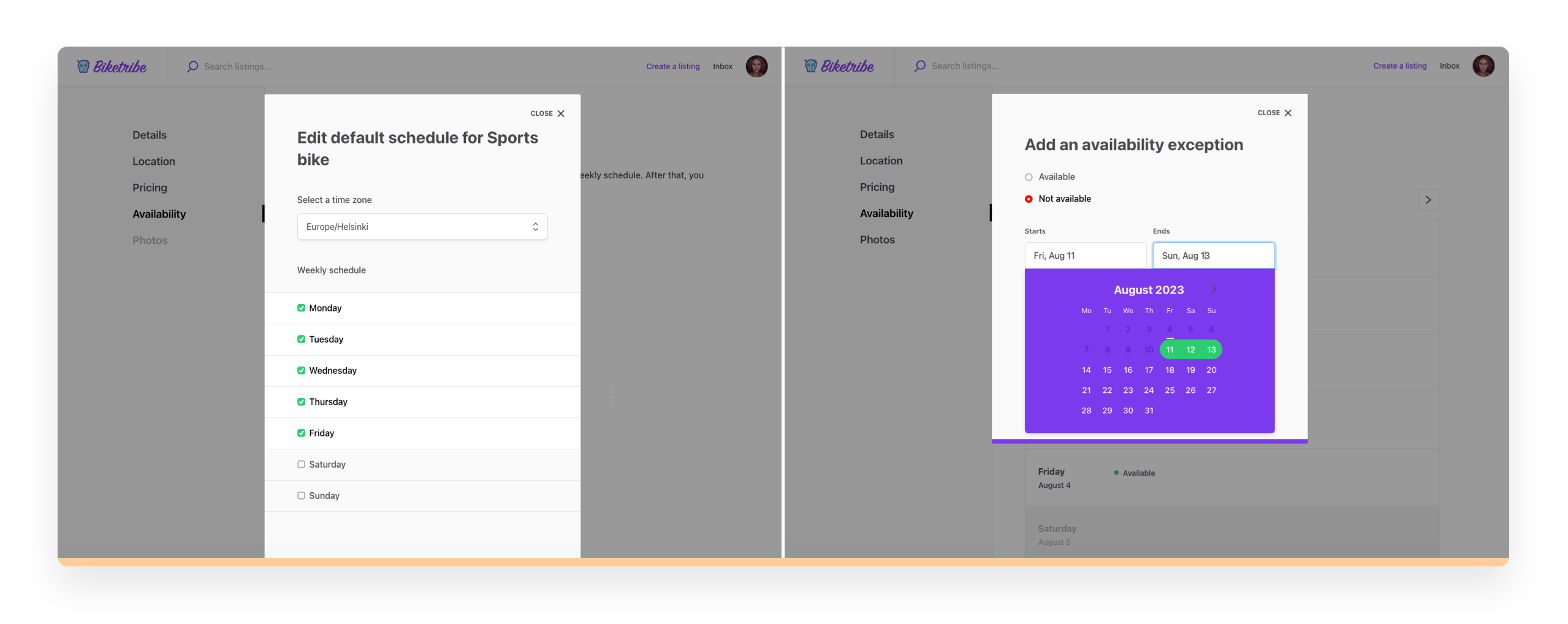
Multi-vendor services marketplaces: Fiverr, Upwork
Service-based marketplaces allow buyers to hire sellers to help them with tasks. These could be anything from professional services like graphic design, construction, or cleaning services to shorter-term tasks like dog walking.
The largest global service marketplaces include Fiverr and Upwork, but there are many successful niche marketplaces, including Sharetribe customer SoftwareSupp.
Similarly to rental-based sites, these platforms need booking calendars, location-based searches, and user profiles with ratings and reviews.
Related:
Here's how you can build a website like Fiverr
It’s not just what your website sells that determines what features you need. It’s also the audience that you plan on marketing your platform to. There are three different types of audiences:
P2P/C2C: audiences on P2P marketplaces value simplicity, security, and streamlined design. Be sure to include profiles, two-way reviews, and simple, secure payments.
B2C: if you’re working with business sellers, be sure to give them all the professional tools they need to manage their business.
B2B: B2B marketplaces require a lot of custom functionality, including complicated transaction flows, contracts, and reporting tools.
Related:
How you want sellers and providers to communicate will impact your feature requirements.
The standard marketplace flow is the most common. On a B2C marketplace like Amazon, a B2B/B2C platform like Fiverr, or P2P site like Airbnb, users go through the motions relatively similarly. Customers enter the site and browse listings. After finding what they want, they initiate a transaction by making a booking, purchasing an item, or contacting the seller.
A reverse flow is also possible. On Upwork, buyers can browse sellers’ profiles and contact the most promising candidates. They can also post a job and ask for sellers to provide quotes.

Of course, there are lots of smaller things to consider in your booking flow. For example, are prices fixed or negotiated? Are bookings scheduled or happen on-demand? Do sellers and buyers need to be verified? Do contracts or NDAs get signed? And so on.
Early-stage marketplace entrepreneurs have various options when they’re ready to start developing their platform. More solutions are available than ever, with choices for everyone from novices to experienced developers.
It’s possible to create a multi-vendor marketplace website from scratch (here's our full-stack developer Mikko's guide to building a marketplace app). But this approach is both time-consuming and expensive: it requires several months of development work from a full-stack technical team. In recent years, open-source marketplace solutions and marketplace website builders have emerged as viable alternatives, offering marketplace entrepreneurs the ability to build flexibly and cheaply.
Let’s break down the different options available and consider the pros and cons of each approach. We'll keep things concise here – check out our article for a full analysis of all the different ways to develop a marketplace website.
Building a multi-vendor marketplace from scratch is time-consuming and expensive.
Open-source marketplace solutions or scripts are available freely on the Internet. With the right expertise, they can help entrepreneurs get their sites up and running faster than building everything from scratch. These open-source solutions tend to be freely available on platforms like GitHub.
Before picking one, read reviews and evaluate whether the frameworks provide the features your platform needs. Most scripts and open-source solutions weren’t built to be expanded, so they may have less than stellar developer experience and prove difficult to scale with. Most solutions use different coding languages.
Pros of using an open-source solution or script
- No need to code everything from scratch – using existing code for the core features may help you launch faster
- Customization – ability to customize features (provided you can code).
- Cost – if you don’t count the cost of development, hosting, and maintenance, open-source solutions are affordable to get started with.
Cons of using an open-source solution or script
- Time to launch – even if using marketplace scripts can save time compared to starting from scratch, they’ll never be as fast as no-code marketplace builders like Sharetribe.
- Technical complexity – using open-source code and frameworks requires technical expertise. If you don’t already have a development team, hiring one can be expensive.
- Scalability – adding custom features can be challenging, and you’ll need to work within the limitations of the open-source framework as you scale.
- Maintenance – ongoing maintenance needs can rack up costs over time.
Dive deeper: Open source marketplaces: the complete guide
Another option to consider is using WordPress themes and plugins to create a multi vendor marketplace. The most popular plugins are WooCommerce and Dokan Multi-vendor.
This helps you launch with a small upfront investment, even if your technical skills are more limited. However, you'll need to use several plugins to get the functionality you need and process payments in a legally compliant manner. That also means maintaining your site will require regular effort.
Pros of WordPress + WooCommerce/Dokan
- Cost – affordable monthly fees.
- Variety – huge selection of themes and plugins.
- Payments – multiple options to process online payments.
- Network – access to the entire WordPress codebase.
WordPress offers a huge selection of themes and plugins. But maintaining them for a secure multi-vendor marketplace experience takes continuous effort.
Cons of WordPress + WooCommerce/Dokan
- Time to launch – while building with WordPress is a lighter technical lift, you’ll need some technical skills and several days of work to get your platform up and running.
- Interdependability of systems – installing, updating, and maintaining a network of plugins takes a lot of work. If one plugin fails or needs an update, there’s a chance your entire marketplace might crash.
- Maintenance – keeping your themes and plugins up to date will regularly require attention. At scale, the cost of hosting and maintenance is considerable.
- Custom-building new features – though it’s possible to customize the WordPress codebase, building entirely new features is much more challenging than with API-based solutions like a self-hosted Sharetribe marketplace.
Dive deeper: Should I build a marketplace with WordPress or a SaaS solution?
There are a variety of eCommerce website builders that you could consider using - the most popular include platforms like Shopify and Magento.
These eCommerce tools are great for building a standard eCommerce website, but you’ll likely encounter limitations when adding multi-vendor features. Let’s explore the pros and cons.
Pros Shopify/Magento
- Features – powerful features for regular eCommerce sites, as well as a suite of apps that you can use to add new features to your store.
- Community: large online communities of users help answer questions. If you need additional developers, hiring should be relatively straightforward.
Cons of Shopify/Magento
- Marketplace functionality – these platforms aren’t meant to build multi-vendor websites, so it might feel like you’re trying to fit a square peg into a round hole. It’s likely you’ll struggle to build key marketplace features, making it difficult to create value for your users. A certain type of B2C multi-vendor product marketplace can work on top of eCommerce builders – other types will very likely miss critical features.
- Payments – often, the payment infrastructure supported by eCommerce platforms isn’t well-suited to the complexity of marketplace payments.
- New features – custom-building new features is challenging, and the architecture of most eCommerce builders doesn’t support the rapid development and launch of new features at scale.
A multi-vendor marketplace builder is your fastest way to market.
Pros of using a marketplace builder
- Speed – Online marketplace builders are the fastest way to launch your business. Sharetribe customers have launched marketplaces in less than a day.
- Accessibility – A no-code marketplace Saas solution like Sharetribe lets you get your website up and running without writing a single line of code. You also won't need to worry about hosting, maintenance, backups, or security.
- Cost – There are minimal upfront costs, and many platforms even offer a free trial. For example, Sharetribe gives you a 14-day free trial, after which you can subscribe to an affordable Build plan at $29/month. You only need to subscribe to a live plan (starting at $99/month( when you're ready to invite in users. Marketplace software providers benefit from economies of scale, which means they can host and maintain your platform at a lower cost than what you'd have to pay for the same services on your own.
- Features – Sharetribe focuses exclusively on powering multi-vendor marketplaces. All the essential features a marketplace needs come out of the box without configuring plugins, extensions, themes, or add-ons. New features are constantly added by expert marketplace developers, so you know your platform is always up to speed with the best practices of the industry.
- Scalability – Once you find yourself starting to need more advanced features, Sharetribe makes it possible to extend your marketplace's functionality and modify its design without changing platforms or migrating data.
- Developer experience – Sharetribe was built from the ground up to be expanded. Customizing the front end, adding third-party integrations, changing the transaction flow, or building entire custom features is fast and enjoyable.
Cons of using an online marketplace builder
- Lower customization with no-code tools – No-code builders usually let you adjust the look & feel of your platform, but the functionality can be limited.
- Monthly subscription – if you don't calculate in the cost of maintaining and hosting your platform, open-source scripts of Wordpress can be more affordable in the long run.
- Limited feature set out of the box – Sharetribe is great for building service and rental marketplaces for all audience types, as well as peer-to-peer product marketplaces like Etsy. For online malls like Amazon, Sharetribe's offering is more limited.
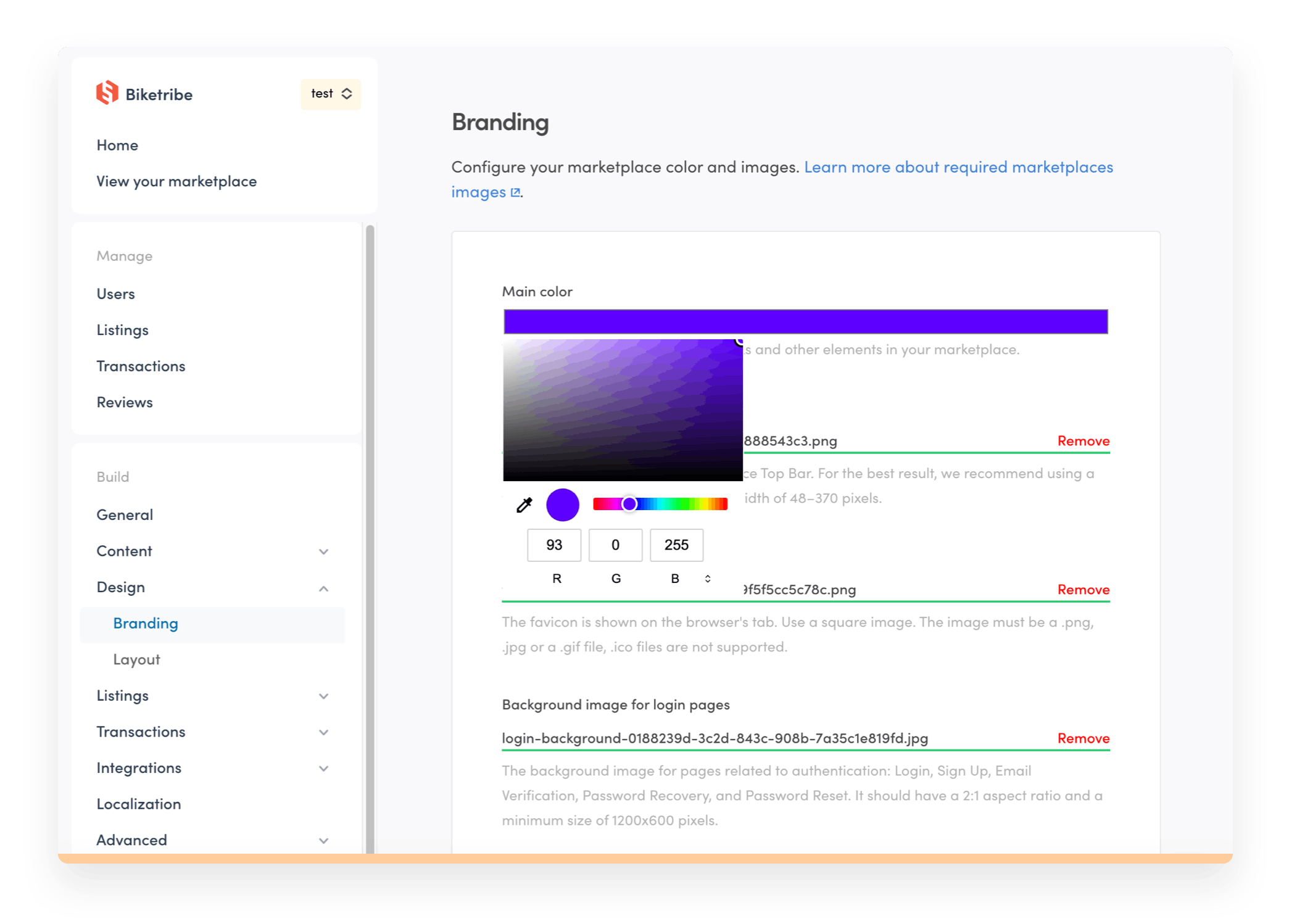
Launching a multi-vendor marketplace with Sharetribe is as simple as following these 10 steps:
- Create your free Sharetribe account and enter your details.
- Add your marketplace's name.
- Build your marketplace's landing page: add a slogan and description that explains what your marketplace does, upload visual assets, and more. Unsplash has great free images, but if you have some budget, check out Stocksy for creative, hand-selected visuals.
- Determine the design of your marketplace: upload a logo and other visual assets photo, and choose the layout of your search page and listing pages.
- Configure your listing settings, listing fields, and search settings.
- Choose your commission and minimum transaction size.
- Test that everything looks like and works to your liking in your Test environment.
- Once everything is ready, it's time to subscribe!
- Activate online payments by connecting a Stripe or PayPal account. You’ll be able to receive payments and collect commissions straight away.
- Check everything over one last time. Congratulations – You’re ready to launch your multi-vendor marketplace – the sky's the limit!

When you find yourself needing these more advanced features, you can build them on top of your existing Sharetribe marketplace.
It's possible to self-host Sharetribe as a headless, API-based marketplace solution. It enables entrepreneurs to create more advanced features uniquely suited to the needs of their business, all the while managing their marketplace in Console.
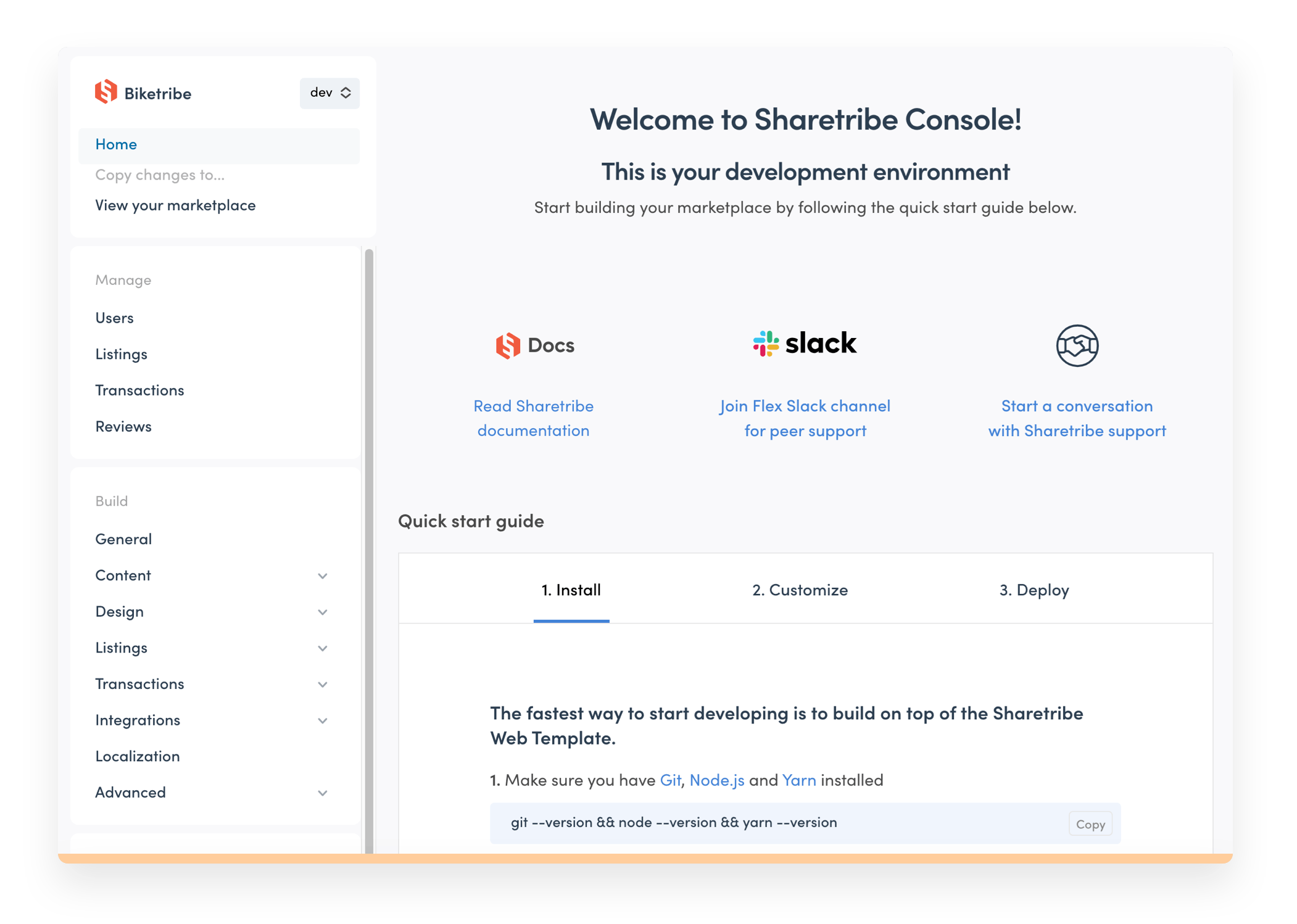
Thanks to Shatretribe's complete customizability, working with Sharetribe self-hosted is a process that is unique to every founder and idea. But more often than not, the process follows these steps.
- Determine the custom functionality and design you want to build on top of your Sharetribe marketplace. This can be anything from a single feature to an entire custom front-end application build.
- Download Sharetribe Web Template, Flex's free template web application, and set up your development environment. Here's a comprehensive getting started guide in Sharetribe's technical documentation. If you don't have a developer on your team, reach out to Sharetribe's verified Expert Partners, discuss your needs and budget, and choose the partner that's right for you.
- Customize the Template to fit your marketplace idea and requirements.
- Set up your customized Template and launch your bespoke multi-vendor marketplace! 🚀
After your marketplace runs on Flex, the sky is the limit. You can keep repeating the build-learn-improve process as your business grows.
Want to introduce multiple new transaction flows? Easy. Integrate third-party services like marketing automation, shipping providers, or user authentication? Sure! Build complete new custom features to serve your niche? Absolutely possible.
While you're growing your business, Sharetribe continues to host your backend, take care of maintenance, security, and compliance, and introduce powerful new feature updates regularly. No matter how ambitious your goals are, you can realize them with Flex.
Building a marketplace is a journey, and the first step is the most important. Need some inspiration? Check out Sharetribe examples in our customer gallery or read our customer stories to learn about entrepreneurs who've created thriving multi-vendor businesses. Want some marketplace business advice? Check out our complete guide on how to build a marketplace.
Stuck? Visit Sharetribe's Help Center. There, you can reach out to Sharetribe's customer support team seven days a week. They’re experts on online marketplaces and will help you as you get familiar with Sharetribe and move your business forward.
Start your 14-day free trial
Create a marketplace today!
- Launch quickly, without coding
- Extend infinitely
- Scale to any size
No credit card required
